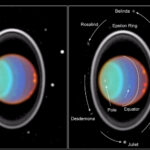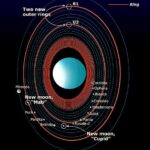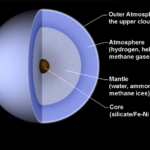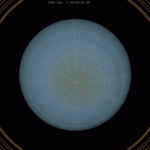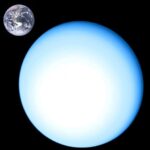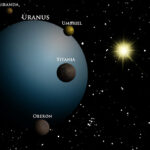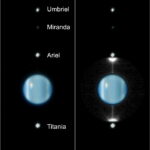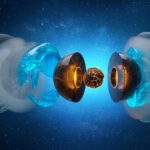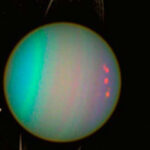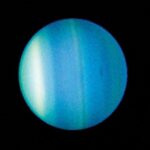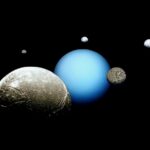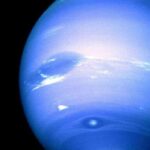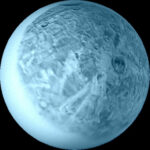Dozens of terraformed moons are here, with more secrets below the thick cloud cover.
–
Table of Contents:
- Introduction
- Spec’s
- Moons
- History
- Maps
- Comparisons and Info
- Far Orbit
- Low Orbit
- Moons
–
Introduction:
This planet was the first to form after Earth, and was what reduced Earth from its former/original gas-giant state. Uranus, like the Earth back then, was gigantic, and it was the later formation of Saturn from these two eldest worlds in the solar system… that reduced this first gas-giant in size by more than half. Uranus’s composition allowed it to maintain its Firmament while Earth began to lose some of its own… and while Saturn formed (including Saturn’s own Firmament) between them. As Saturn grew to be the largest and central of the three worlds, its increasing presence held both the Earth and Uranus tidally locked to it; each of those two had one side facing the new central gas-giant at all times, which, for a long time, kept the Earth somewhat disc-like (as opposed to the oblate hollow spheroid it is today) and Uranus tilted almost 90°. If so many other worlds hadn’t started by feeding off the once-deeper atmosphere of primordial-Earth, Earth and Uranus would still be roughly the same size and color.
–
Planet Info:
This is the Sun solar system’s most tilted planet.
| Discovery | |||||||||||||
|---|---|---|---|---|---|---|---|---|---|---|---|---|---|
| Discovered by | William Herschel | ||||||||||||
| Discovery date | March 13, 1781 | ||||||||||||
| Designations | |||||||||||||
| Pronunciation | /ˈjʊərənəs/ ( |
||||||||||||
| Adjectives | Uranian | ||||||||||||
| Orbital characteristics[1][a] | |||||||||||||
| Epoch J2000 | |||||||||||||
| Aphelion | 20.11 AU (3,008 Gm) |
||||||||||||
| Perihelion | 18.33 AU (2,742 Gm) |
||||||||||||
| 19.2184 AU (2,875.04 Gm) |
|||||||||||||
| Eccentricity | 0.046381 | ||||||||||||
|
|||||||||||||
| 369.66 days[4] | |||||||||||||
|
Average orbital speed
|
6.80 km/s[4] | ||||||||||||
| 142.238600° | |||||||||||||
| Inclination | 0.773° to ecliptic 6.48° to Sun‘s equator 1.02° to invariable plane[5] |
||||||||||||
| 74.006° | |||||||||||||
| 96.998857° | |||||||||||||
| Known satellites | 27 | ||||||||||||
| Physical characteristics | |||||||||||||
|
Mean radius
|
25,362±7 km[6][c] | ||||||||||||
|
Equatorial radius
|
25,559±4 km 4.007 Earths[6][c] |
||||||||||||
|
Polar radius
|
24,973±20 km 3.929 Earths[6][c] |
||||||||||||
| Flattening | 0.0229±0.0008[b] | ||||||||||||
| Circumference | 159,354.1 km[2] | ||||||||||||
| 8.1156×109 km2[2][c] 15.91 Earths |
|||||||||||||
| Volume | 6.833×1013 km3[4][c] 63.086 Earths |
||||||||||||
| Mass | (8.6810±0.0013)×1025 kg 14.536 Earths[7] GM=5,793,939±13 km3/s2 |
||||||||||||
|
Mean density
|
1.27 g/cm3[4][d] | ||||||||||||
| 8.69 m/s2[4][c] 0.886 g |
|||||||||||||
| 0.23[8] (estimate) | |||||||||||||
| 21.3 km/s[4][c] | |||||||||||||
|
Sidereal rotation period
|
−0.71833 d (retrograde) 17 h 14 min 24 s[6] |
||||||||||||
|
Equatorial rotation velocity
|
2.59 km/s 9,320 km/h |
||||||||||||
| 97.77° (to orbit)[4] | |||||||||||||
|
North pole right ascension
|
17h 9m 15s 257.311°[6] |
||||||||||||
|
North pole declination
|
−15.175°[6] | ||||||||||||
| Albedo | 0.300 (Bond)[9] 0.488 (geom.)[10] |
||||||||||||
|
|||||||||||||
| 5.38[11] to 6.03[11] | |||||||||||||
| 3.3″ to 4.1″[4] | |||||||||||||
| Atmosphere[13][16][17][e] | |||||||||||||
| 27.7 km[4] | |||||||||||||
| Composition by volume | (Below 1.3 bar) Gases:
Ices:
|
||||||||||||
Further details here.
–
Uranus’s Moons:
This planet has 27 publicly-acknowledged moons. Four of them are fairly sizable. Of those four, all are colonized and full of many tourism opportunities.
–
History:
Formed in prehistoric times by Earth’s then-thicker atmosphere separating into two parts, this was the biggest gas-giant in the Sun system until Jupiter (which formed, in large part, from the similar division of Uranus’s atmosphere). It still holds the title of first gas-giant formed here. It also still has many of the deities from that time residing in it.
More TBA…
–
Maps:
–
Comparisons and Info:
–
Far Orbit:
–
Low Orbit:
–
Moons:
–

